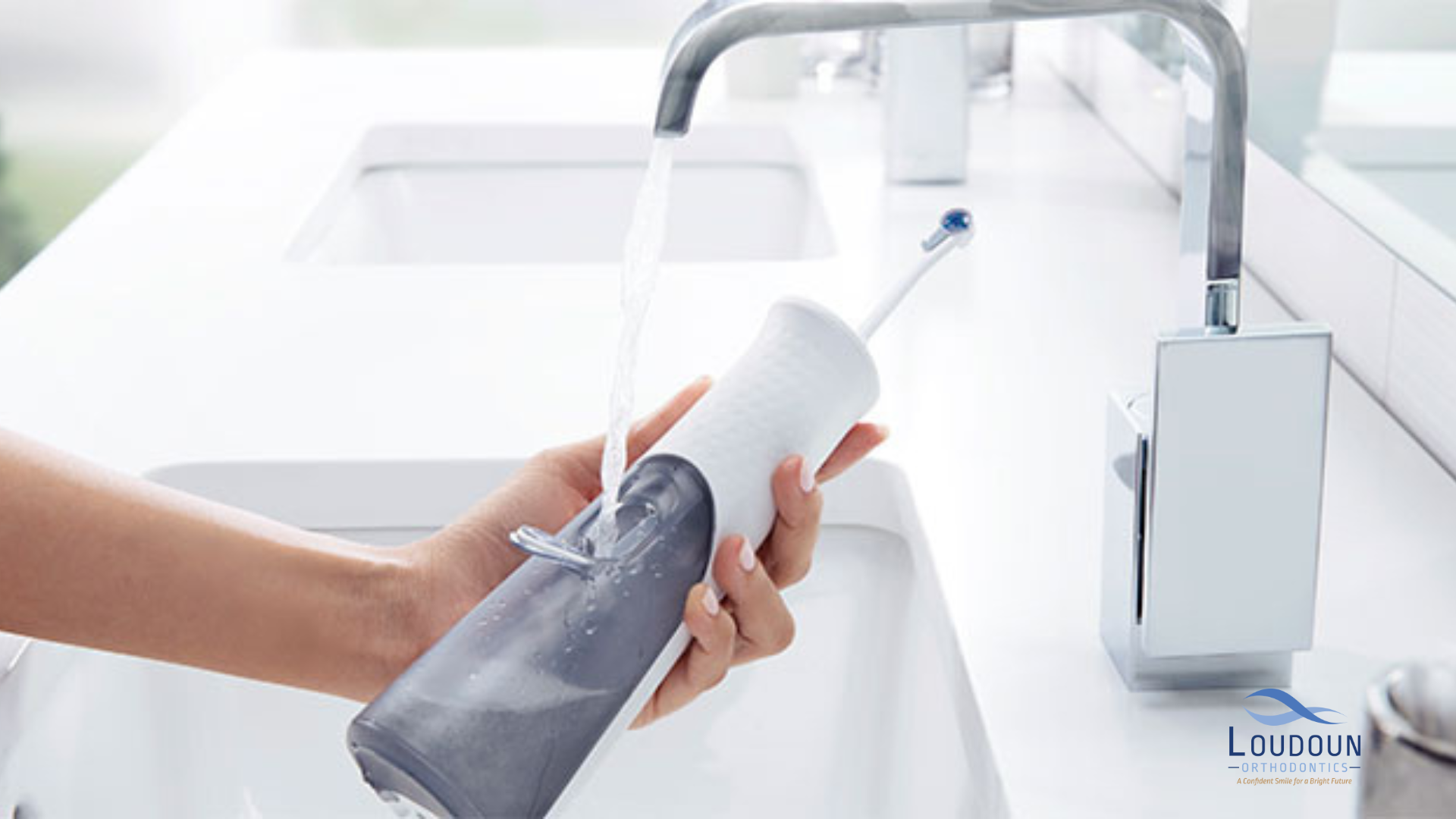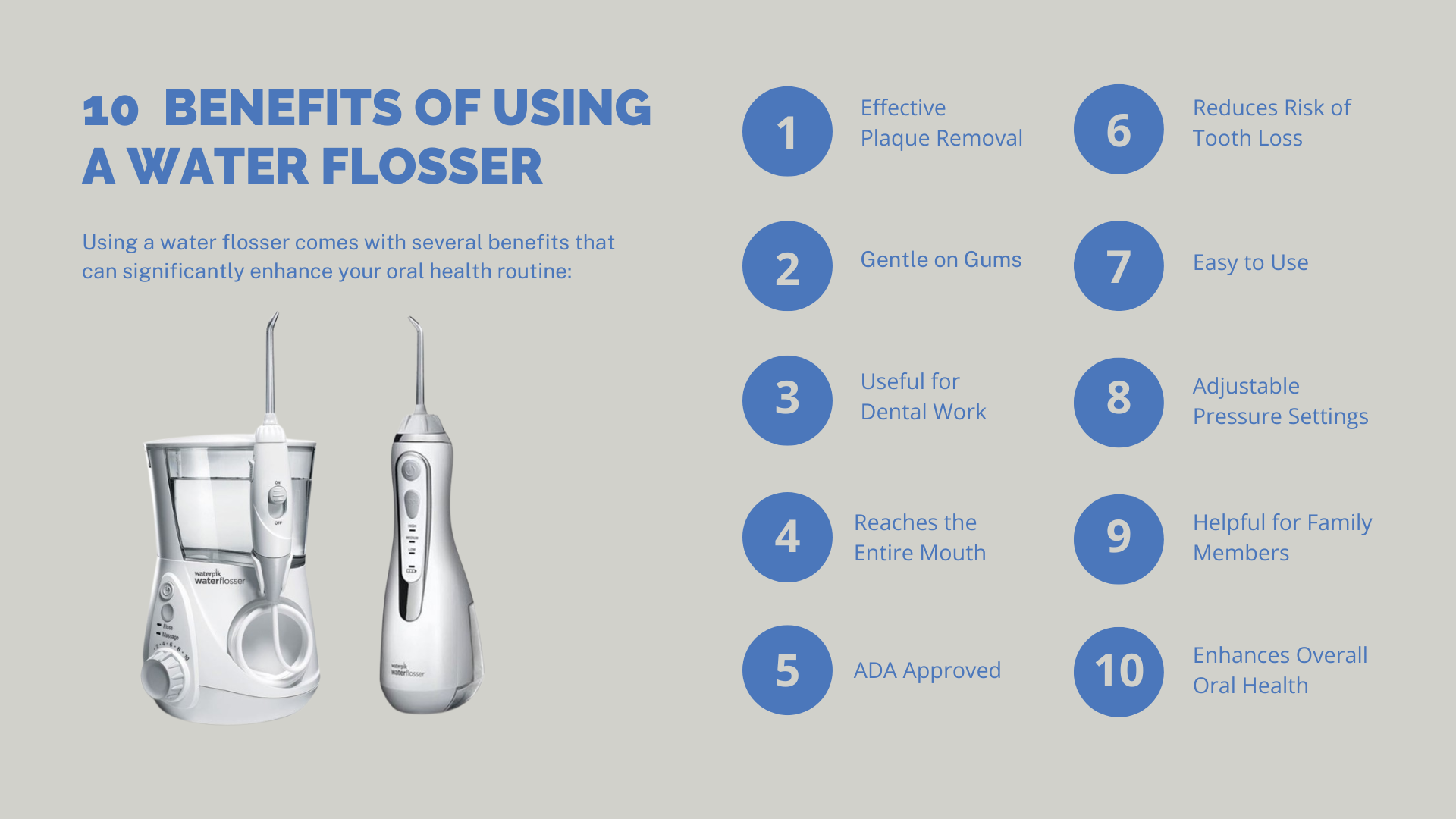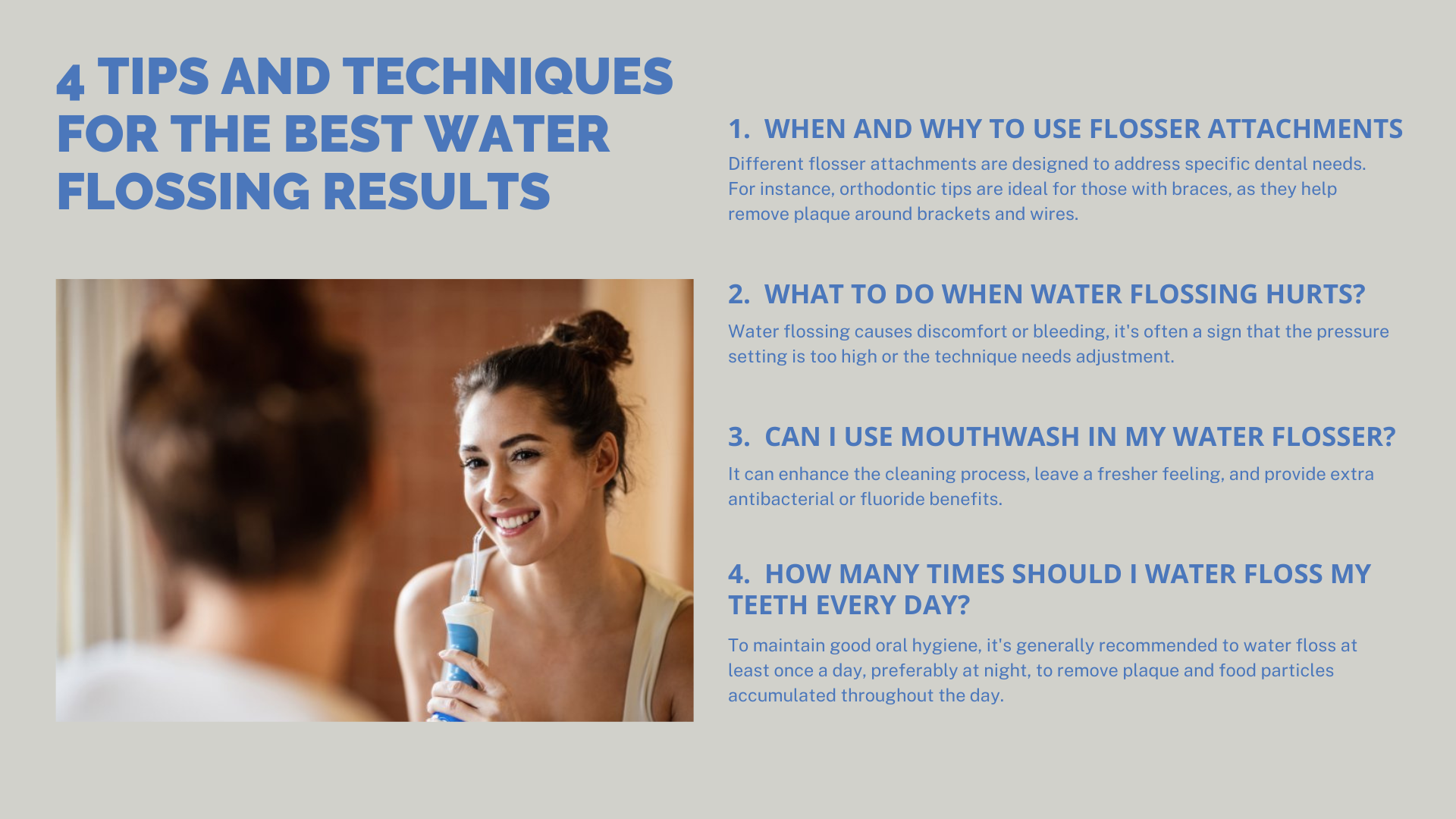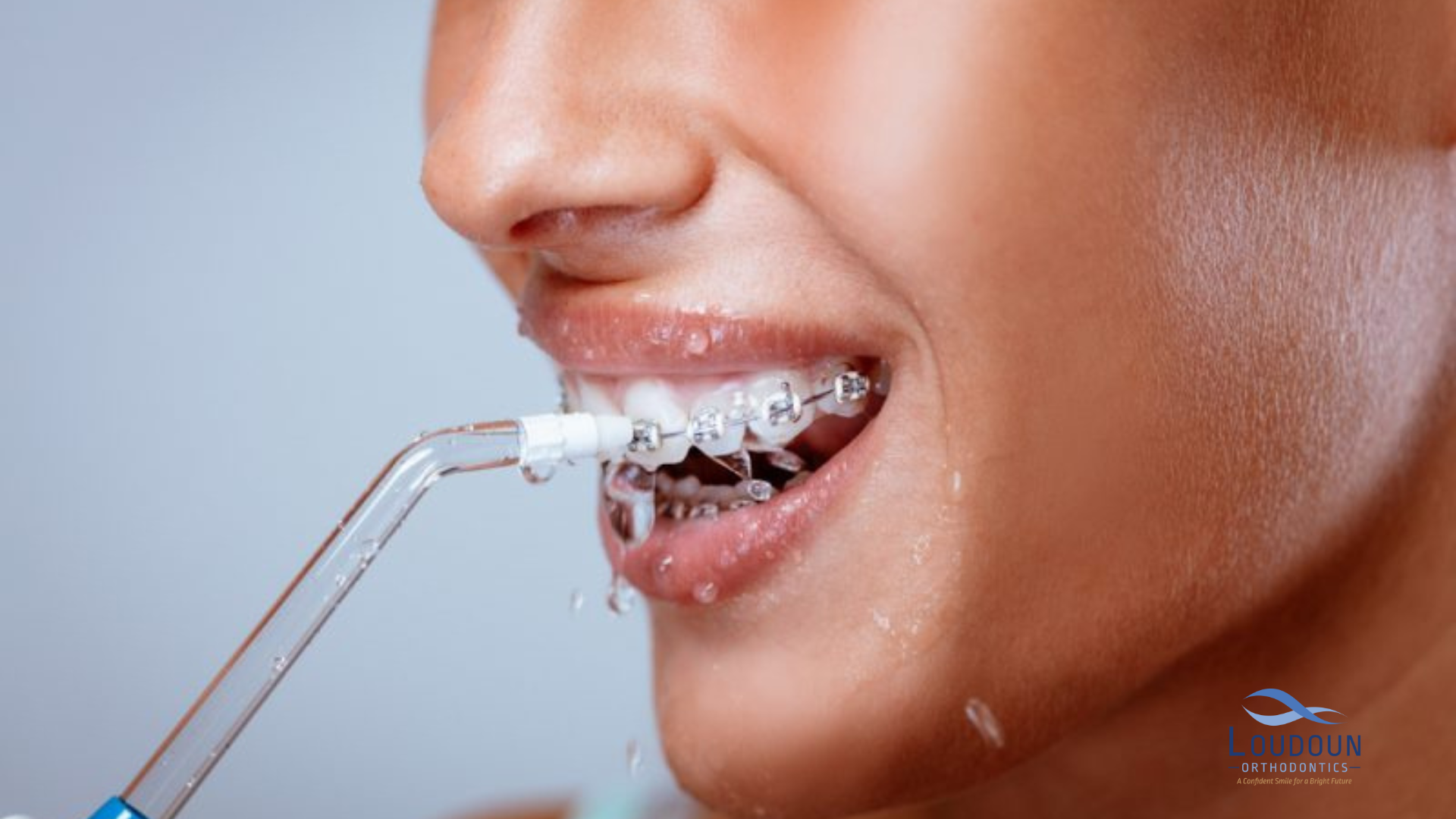We’ve all experienced it—the struggle with toothpicks that snap, the annoyance of waxy floss that seems to have a mind of its own, and the diligent brushing that doesn’t quite conquer trapped food particles and persistent plaque.
Now, picture a solution that not only tackles these common frustrations but also transforms your oral hygiene routine into something effective and enjoyable.
Welcome to the realm of water flossing, a revolutionary advancement in dental care technology crafted to address areas where traditional methods often fall short!
Table of Contents
What Is a Water Flosser?

Meet the game-changer in dental hygiene—the water flosser, a.k.a. the oral irrigator, revolutionizing the way we care for our pearly whites. Unlike the traditional dance with floss or string, a water flosser opts for a pulsating stream of water to bid farewell to food particles, plaque, and bacteria between teeth and the gum line.
This nifty contraption is especially a hero for those with braces, dental implants, or those who have danced with orthodontic treatments. In these cases, where the standard dental floss might throw in a challenge or two, the water flosser steps up to the plate, offering an effective and convenient alternative.
Enter the water flosser, a potential game-changer for those mindful of gum or periodontal disease. Its gentle yet effective prowess in cleaning periodontal pockets and minimizing gum recession makes it a top pick for gum health enthusiasts. This nifty tool shines, particularly for individuals with dental work such as implants, where preserving a radiant smile is non-negotiable.
Its simplicity adds to its appeal—just fill the reservoir with water, pick your desired pressure setting, and effortlessly guide the tip along your gum line and between teeth. It’s easy as pie!
Whether flying solo or joining forces with the classic duo of brushing and flossing, the water flosser emerges as a reliable ally in maintaining a pristine, healthy mouth. Its contributions extend to reducing the risk of tooth loss and ensuring your smile stays radiant.
Water Flosser vs. Traditional Flossing: What’s the Difference?
The ongoing debate surrounding the choice between a water flosser and traditional string floss for maintaining oral health is a topic of interest.
The crux of the matter lies in their mechanisms and effectiveness in different scenarios. A water flosser opts for high-pressure, pulsating water to bid farewell to food particles, plaque, and bacteria nestled between teeth and the gum line.
This approach proves particularly advantageous for navigating the tight nooks around dental work, such as braces or dental implants, and for reaching the recesses at the back of the mouth, where manual flossing can pose a challenge. It’s a clash of methods, each with its strengths in specific dental territories.
Now, let’s flip the coin to traditional flossing, where a slender piece of string floss takes center stage, becoming the hands-on hero in scraping plaque and dislodging food particles between the teeth and gums.
This technique proves effective in plaque removal, but it might stumble in efficiency, especially around orthodontic treatments or those elusive corners of the mouth. Individuals with sensitive gums or experiencing gum recession might find traditional floss harsh, potentially causing discomfort or bleeding.
Switching from the familiar string floss to the water flosser might involve a slight learning curve, but many discover that water flossing offers a more enjoyable experience overall. The sensation of water flossing is gentler compared to its traditional counterpart, decreasing the likelihood of bleeding gums while maintaining effectiveness in cleaning between teeth and gums. It’s a shift in technique that often leads to a more pleasant oral care routine.
Can a Water Flosser Replace Traditional Flossing Completely?
The debate over whether a water flosser can replace traditional flossing depends on individual oral health needs. Water flossers excel in flushing out particles from tricky spots, where traditional floss may struggle. Some dentists recommend using both methods for optimal oral hygiene.
Water flossers are great for gum health, while traditional floss effectively removes plaque. A balanced mix of both techniques could be the key to preventing gum and periodontal diseases. It’s a dental duet, each playing its part for the greater good of your pearly whites.
Do Dentists Recommend Water Flossing?
Dentists and dental hygienists frequently advocate including water flossers in a holistic oral health routine.
The American Dental Association (ADA) has bestowed the ADA Seal of Acceptance upon specific water flossers, recognizing their prowess in removing plaque and enhancing gum health.
Diverging from manual brushing or traditional flossing, which may overlook tight spaces, especially around rear teeth, water flossers employ a high-pressure water stream to reach every nook and cranny of the mouth, guaranteeing a comprehensive clean.
How Long Do Water Flossers Last?
With proper care and maintenance, a high-quality water flosser can last several years. Regular cleaning of the reservoir, handle, and tips is crucial to extending the device’s life and preventing bacteria buildup.
Using the correct pressure setting and avoiding overworking the motor can contribute to a longer lifespan. Many patients find that investing in a quality water flosser proves cost-effective over time, given its benefits for oral hygiene and gum health.
Water flossers offer a practical, efficient alternative to traditional flossing, especially for those with specific dental needs or preferences. While they may not replace string floss entirely for everyone, they are a valuable tool in the lineup of dental hygiene products, ensuring a healthy mouth and smile.
Does Water Flossing Work?

Water flossing has become a popular and effective tool for maintaining oral health, utilizing water at different pressures to clean between teeth and along the gum line, unlike manual brushing or standard dental floss.
Studies and endorsements by dental professionals, including those associated with the American Dental Association (ADA), affirm the effectiveness of water flossing in removing plaque and preserving oral hygiene.
Regular use, typically twice daily, can significantly enhance an individual’s oral hygiene routine through the use of water flossers.
Can Water Flossers Remove Plaque Effectively?
Water flossers’ popularity is largely due to their effectiveness in removing plaque. Plaque, the main contributor to tooth decay and gum disease, is effectively targeted by water flossing.
By directing a continuous stream of water into the spaces between teeth and below the gum line, water flossers excel in dislodging and removing plaque and food particles often missed by manual brushing or traditional dental floss.
Dental hygienists often recommend water flossers as a supplementary tool for plaque removal, particularly for individuals facing challenges with conventional flossing methods. Consistent use of a water flosser can lead to a noticeable reduction in plaque buildup, contributing to healthier teeth and gums.
Can Water Flossing Help Prevent Gum Disease?
Water flossing significantly prevents gum disease by efficiently removing plaque and reducing the likelihood of tartar formation.
The pulsating action of water flossers effectively cleans below the gum line, where gum disease often initiates. Water flossing is a gentler and more comfortable option for patients with existing gum issues and is less likely to cause bleeding than traditional flossing.
Dentists commonly recommend water flossing to patients displaying early signs of gum disease, as it aids in controlling progression and sustaining overall gum health.
Incorporating water flossing, brushing, and regular dental check-ups into a daily oral care routine substantially reduces the risk of gum disease and promotes a healthy oral cavity.
What Are the Benefits of Using a Water Flosser?

Incorporating a water flosser into your oral care routine brings forth numerous advantages that can notably elevate your dental health practices:
- Effective Plaque Removal: Water flossers excel at eliminating plaque from teeth and gum lines, serving as a formidable defense against tooth decay and periodontal disease.
- Gentle on Gums: Unlike conventional dental floss, which may induce bleeding, especially in sensitive gums, water flossers provide a gentler and less abrasive cleaning experience.
- Useful for Dental Work: Particularly beneficial for individuals with braces or other dental work, water flossers navigate around these structures more efficiently than manual brushing or traditional floss.
- Reaches the Entire Mouth: Water flossers access deeper into gum pockets and between teeth, addressing areas often overlooked by toothbrushes or standard floss.
- ADA Approved: Many water flossers bear the American Dental Association (ADA) Seal of Acceptance, attesting to their effectiveness and safety.
- Reduces Risk of Tooth Loss: Water flossers minimize conditions that may lead to tooth loss by proficiently removing plaque and sustaining gum health.
- Easy to Use: Despite a brief learning curve, most individuals find water flossers more convenient and comfortable than traditional floss, particularly for cleaning posterior teeth.
- Adjustable Pressure Settings: Equipped with adjustable settings, water flossers empower users to regulate water pressure, ensuring a comfortable and personalized cleaning experience.
- Helpful for Family Members: Water flossers can accommodate multiple family members, each with their own tips, making them a versatile tool for the entire household.
- Enhances Overall Oral Health: Regularly incorporating a water flosser, brushing, and flossing elevates oral hygiene and overall dental health.
Integrating a water flosser into your daily dental care routine provides a thorough cleaning experience, promoting healthier teeth and gums and potentially minimizing visits to the dentist for issues related to poor oral hygiene.
4 Tips and Techniques for the Best Water Flossing Results

Optimizing the outcomes of water flossing goes beyond simply using the device; it’s about mastering the technique and understanding how to employ it effectively.
1. When and Why to Use Flosser Attachments
Various flosser attachments are crafted to cater to specific dental needs. Orthodontic tips, for example, are perfect for individuals with braces, as they assist in removing plaque around brackets and wires.
Pik pocket tips can benefit patients with periodontal disease, reaching deeper into periodontal pockets.
Incorporating these attachments into your water flossing routine can elevate its effectiveness, particularly for targeted cleaning and individuals with specialized dental work.
2. What to Do When Water Flossing Hurts?
If water flossing leads to discomfort or bleeding, it’s usually an indicator that the pressure setting is too high or the technique needs refinement. Begin with the lowest pressure setting and gradually increase it as you acclimate.
Angle the tip along the gum line and glide it gently between teeth, ensuring comprehensive coverage, including the back teeth. Adjust the pressure setting to target areas prone to plaque buildup.
To achieve optimal plaque removal and maintain oral health, it’s crucial to be thorough yet gentle during each water flossing session.
If discomfort persists, it’s advisable to consult with a dentist or dental hygienist. This step ensures a thorough assessment of any underlying oral health issues and provides personalized guidance on correctly using the water flossing device.
3. Can I Use Mouthwash in My Water Flosser?
Numerous dental professionals concur that incorporating mouthwash into the reservoir of your water flosser can be advantageous.
This addition can elevate the cleaning process, impart a fresher feeling, and offer additional antibacterial or fluoride benefits.
Using mouthwash in moderation and diluting it with water is crucial to avoid potential damage to the device. Always consult the manufacturer’s instructions before adding anything other than water to the reservoir.
4. How Many Times Should I Water Floss My Teeth Every Day?
To maintain optimal oral hygiene, it is generally advised to water floss at least once a day, preferably at night. This helps remove accumulated plaque and food particles from throughout the day.
Individuals with braces, implants, or a tendency for tartar buildup may opt to water floss twice daily for a more thorough clean.
Consistent daily use is paramount with any oral hygiene tool to achieve the best results for your dental health.

Proudly Offering Teeth Straightening Services in Leesburg, VA, for Over 20 Years!
Contact Loudoun Orthodontics if orthodontic care is the solution to your dental woes. Whether you want to learn more about the benefits of orthodontic care or have questions about the process, use our live chat or call (703) 858-0303 or message us through our Contact Us page to connect with our friendly staff today and book a complimentary consultation!
Our office, located at 19465 Deerfield Ave. Suite 304, Leesburg, VA 20176, proudly serves the Loudoun County. So, if you’re residing in Ashburn, Leesburg, or Sterling and are looking for one of the best orthodontists in Northern Virginia, don’t hesitate to visit our office!
We also invite you to keep up with our blog to get answers to many of the frequently asked questions about maintaining your perfect smile, and follow us on Facebook and Instagram to become a part of our smiling community!
References
- American Dental Association. (2024). Home. American Dental Association. https://www.ada.org/
- Lemons, A. (2023, May 31). Do water flossers work? A hygienist’s quest to find out. RDH Magazine. https://www.rdhmag.com/patient-care/home-care/article/14294592/do-water-flossers-work-a-hygienists-quest-to-find-out

